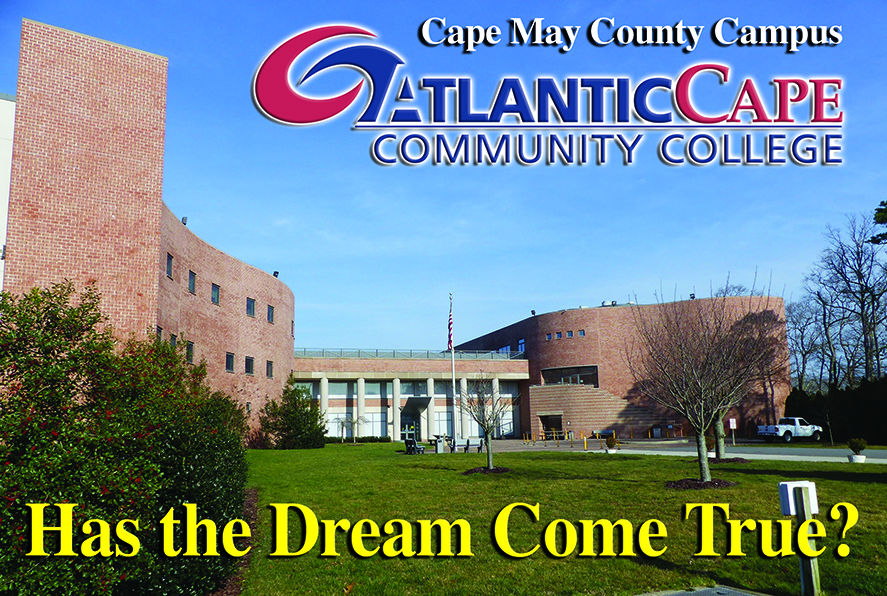This is the second in a series that focuses on Atlantic Cape Community College’s decade-old Cape May County Campus.
COURT HOUSE – The ribbon was cut at the new Atlantic Cape Community College campus in Court House Aug. 24, 2005. That same day long-time late Herald Editor Joe Zelnik, a tireless advocate for the establishment of a community college in the county, began his column by celebrating the fact that the “county finally loses its shameful distinction as the only one in the state without a community college.”
The struggle to bring a college to the county had taken over a decade. The final result had elements of a compromise. The fully independent college supporters had fought for had proven too great a reach.
There was not always a consensus within the county on the need for a local community college. For some the benefits of a two-year college did not outweigh the projected expense. In 1993, supporters gained enough backing so that the county submitted a formal request to the state for an independent county-based community college. The following year, Freeholder candidate Jeff Van Drew (now a state senator) made support for such a college a major issue in his campaign.
Meanwhile business as usual was for the county to appropriate about $2 million a year so that residents could attend community colleges in Atlantic and Cumberland counties. Atlantic County College received the bulk of those payments.
State officials denied the request for an independent college and urged the county to explore an arrangement with a neighboring institution. Confronted with the reality that an independent school was not going to gain approval, county supporters of the higher education initiative reluctantly moved to fashion a jointure agreement. The joint Atlantic Cape Community College came into existence Jan. 1, 1999.
Early Controversies
From the start practical issues of funding and site selection for a branch campus took precedence over programmatic concerns.
The first application for support from a $50-million fund at the New Jersey Council of Community Colleges resulted only in a promise of $3 million spread over two years.
Dr. John May, then president of the institution, said the money would be enough to start the planning and permitting processes for the college. Optimism abounded with officials setting a fall 2001 target date for completion of a branch campus.
That date would be missed by four years, with the campus at its present site in Court House finally opening in 2005.
May repeatedly stated that the building of the branch campus was among the highest goals for the institution. Larger funding of $12 million was eventually secured in the form of a loan with the Cape May County freeholders obliged to pay half plus interest while the state would cover the other half. The campus would eventually cost $15.1 million.
The emerging reality of a joint institution made determining the basis for Cape May County’s contribution imperative. State requirements based the funding formula on county ratables rather than enrollment. Legislation was needed and finally obtained to change the process to one based on use.
As the construction money and shared funding issues worked themselves out, the principle controversy that would delay the opening of the new campus was site selection. The fight over a site was long and at times ugly, with more than its share of protests, legal challenges, and interminable delays.
Court House Site
At the inception of the joint agreement, the favored site for the new campus was in the sprawling Crest Haven Complex, east of Garden State Parkway. A plot of land considered would have required moving the Prosecutor’s Office and reallocation of land from the technical school. The acreage also was adjacent to a sludge treatment facility owned by the county Municipal Utilities Authority. One early concern was “odor remediation.”
A site selection committee was formed as municipalities in the county vied for the right to house the new campus.
Dennis Township proposed a 31-acre site where Routes 9 and 83 meet.
Woodbine offered a 29-acre site used as cornfields on Route 550. Woodbine and its Mayor William Pikolycky, would continue to push the site long after the Court House location was selected. His view of the fairground location in Court House was clearly expressed when he said the county “was trying to put 100 pounds in a 50-pound bag.”
The selection committee picked the fairground site using land already owned by the county. It pointed to the central location in Middle Township, proximity to Rutgers Cooperative Extension Service and other educational institutions, and its accessibility to individuals from the north and south ends of the county.
While some opposition may have been anticipated, no one saw the extent of the controversy that selection would produce.
Neighborhood groups, environmental organizations, and state permitting processes repeatedly delayed the project and added to its costs. Neighbors objected to the site and what they projected would be the negative impacts on quality of life.
Environmental analysis led to the discovery that the site was home to two endangered species, the Southern Gray Tree frog and Eastern Tiger salamander. Higher than expected construction bids forced accommodations to the design.
The need for sewer extension and coastal building permits caused other delays until a settlement between the county and the state Department of Environmental Protection. Most importantly, a deal to allocate acreage from the state Green Acres program to the college location needed approval. That approval was long delayed even after the county promised $500,000 for purchase of open land elsewhere as compensation.
Lawsuits went to the Appellate Court level creating an environment in which the county and college had to proceed always knowing there was a risk to their investment if they lost the legal battles.
May remained steadfast in support of what he called “an ideal location,” but frustration mounted. At one point, when the state continued to withhold approval of the Green Acres proposal, the college had post cards printed with a picture showing a sign in front the location saying “Site of the Future ACCC Campus Coming in 2002, 3, 4?”
A confluence of decisions finally led to approval of the new site. Green Acres approval came in 2002 allowing the groundbreaking for the site attended by Gov. James McGreevy. He said the agreements would “sow the seeds” for a better educated workforce and a stronger economy. Freeholders agreed that the challenge before the county was “a better educated workforce.”
The goal most discussed at the time was for Atlantic Cape Community College to expand its programs in the county and to tailor those programs to the county’s workforce needs. In 2003 a court rule ended the long litigation.
Financial concerns and site selection so dominated the early years after the joint agreement that programmatic concerns were seldom at the forefront of public discussion. Press coverage of speeches gave evidence of a general agreement that a better educated workforce was a principal goal, but as always the devil would be in the details.
Governance
The agreement to create Atlantic Cape Community College established a shared governance structure for the institution. Atlantic County would get seven seats on the Board of Trustees and Cape May County five.
Cape May County officials applauded the fact that the county would finally have a governance role and a “clear role in the financial decisions of the college.” They saw an opportunity for “substantially expanded service” to the county and the development of curricular programs centered in the new campus.
A reading of the minutes from trustee meetings during those early years of the joint agreement provides no coherent vision emanating from the county’s new members on the board. Again unexpected difficulties compelled that the initial focus was almost solely on getting the campus built.
Amid years of delays, May announced his retirement as president. He would leave his position just as the new campus opened in 2005. A search was begun. The hope was that May’s commitment to the new regional institution would be transferred to his replacement.
There were 53 applicants and four finalists for the position, three of whom were from outside the state. In the end, Dr. Peter Mora, a 30-year veteran of the institution, was selected. Mora had served in a number of roles that provided him with direct involvement in the Cape May County expansion.
Mora took office July 1, 2005 with the open house for the new campus one month away and the first academic term for the facility set to begin in September.
Now, as Mora approaches retirement, the Cape May County campus continues to be cited as one of the major accomplishments of his tenure.
Classes, Enrollments and Dreams
Almost as soon as the jointure agreement was signed, the college extended its offerings in Cape May County. By the end of 1999, the college was offering 80 classes at the Cape May County Extension Center in Rio Grande, in a small mall where Joe Canal’s is located, and the Technical High School.
By spring 2000, reports showed that 4,104 students were taking classes in Mays Landing, 567 in Atlantic City, and 550 in Cape May County. Those were good years for growth in community colleges across the country. A slumping economy is usually good for business in the notoriously counter cyclical world of higher education as individuals seek retraining for better job prospects.
Just as the year of the new campus’ inauguration dawned the state as a whole had some 300,000 students enrolled in community colleges. Enrollments were almost evenly split between those seeking a two-year degree, with possible expectations for transfer to a four-year institution, and those seeking professional development or career-oriented programs. The dual mission of community colleges was evident.
In 2005, the college came out with its five-year strategic plan, developed under the guidance of May who was still president when it emerged.
The plan’s vision statement placed emphasis on outstanding academic and training programs without giving one preference over the other. It placed a focus on innovative delivery methods, on affordability, and on promoting student success and retention.
As the plan articulated the institution’s mission, it emphasized the need to respond “to community and training needs” and “support of a dedicated high-quality work force.”
If one reads the comments of both the educators and the county and municipal officials through those years of struggle to bring a campus to the area, there was an emphasis on both the academic and the workforce development roles that community colleges have traditionally had to balance.
No one really knew what the enrollments would be, what offerings would become staples of the Cape May County curriculum, or what innovative uses businesses in the county would find for a post-secondary education institution conveniently located for county residents.
The goals and the vision had been painted with a broad brush, bolstered by enthusiasm for something the county had long been missing. How the synergies would work out was less clear.
The campus opened its doors amid much enthusiasm and many ambiguities. New leadership at the college increased the uncertainty. Political leaders saw the brick-and-mortar campus as a sign of clear achievement. Ribbon was cut, students enrolled, and the county and the college seemed content with a feeling of euphoria at a task accomplished.
Zelnik ended his column on opening day with the caution that “Now the focus must be on what’s ahead.” It was time to turn dreams into realities.
To contact Vince Conti, email vconti@cmcherald.com.
ED. NOTE: Conti has had a 35-year career in higher education as a teacher and senior administrator. Among other roles, he served as Vice Dean of Arts and Sciences at The University of Pennsylvania and the chief operating officer of the University of Maryland University College. He has also worked extensively with Historically Black Universities and Colleges in the U.S. and with institutions of higher education in Europe and Latin America.
North Cape May – Another shout out to Officer Bohn, the school resource officer at LCMR. I admire his hard work and devotion to the students and staff as I see him every morning and afternoon, snow, wind , sleet or…








